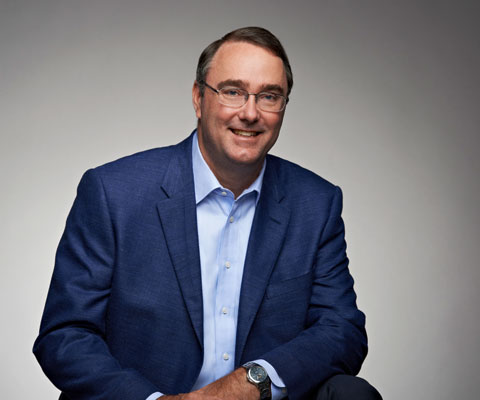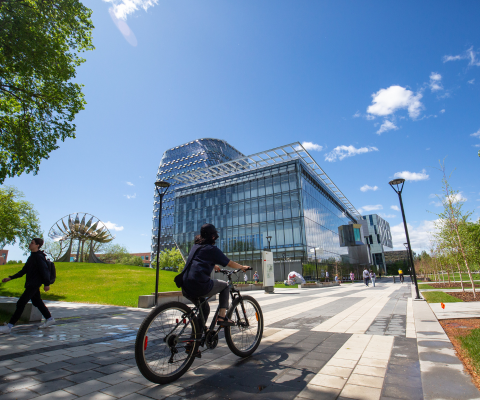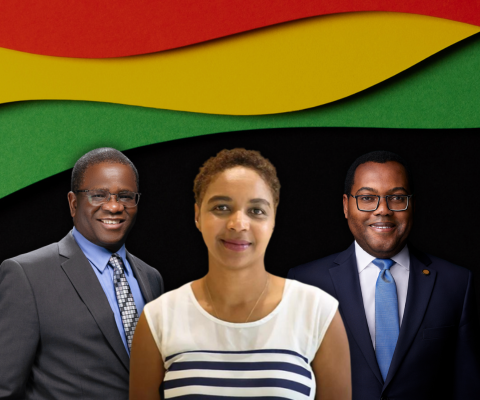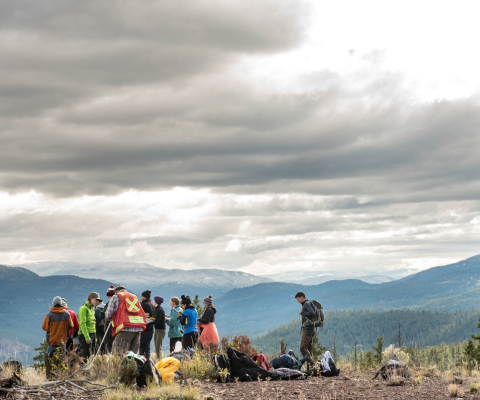Smart Skills for a Smarter Canada

Speech
Economic Club of Canada – Ottawa
Paul Davidson
President, Association of Universities and Colleges of Canada
Check against delivery
[Greetings]
Thank you David, and thank you to the Economic Club.
It is great to see so many friends of higher education, research and innovation here.
En français, one speaks of this time of year as “La Rentrée” – the return – back-to-school, back-to-Parliament, back-to-work. It is good to be back. The work we are all doing together is important to Canada.
One iconic image of “La Rentrée” is the yellow school bus picking up students and taking them to school. It is a reminder that Canada’s public education system, publicly funded, publicly delivered, and open to all is one of Canada’s great competitive advantages. And one of our greatest achievements.
And I want to speak both of achievement and ambition today.
Let me start with a question this afternoon. How many of you have just seen a child off to university or college? It’s a peculiar mix of pride and panic, isn’t it?
You probably had some advice for your new student. I have three sons — one in university and two completing high school. I know the temptation. Your advice was probably based on your own experience.
I’m in a bit of a unique position as head of AUCC. I’ve visited over 80 campuses across the country. I’ve met with students, professors and administrators and I’ve walked through their labs, sat in their lecture halls and, yes, eaten the on-campus food.
I’ve heard about their successes and where they need help. Even in just five years at the helm of AUCC, I have seen tremendous change and growth on university campuses across the country.
It’s all with an unwavering focus: to equip students with the critical thinking and knowledge-based skills they will need to launch their careers and contribute to this great country.
As for the advice we’re giving our children, I’ll let you in on a secret. If you have a kid old enough to be in university, your own university experience will not resemble theirs in any way.
Let’s go back to the 1980s.
Ferris Bueller and his friends were heading off to university. They were using landlines, electric typewriters or maybe a Commodore 64.
Research was done almost exclusively in the library or lab.
As for me, I had left my family home in Toronto landing down the highway at Trent University in Peterborough. While it felt like a different world, let’s be honest. The language, food and basic culture really didn’t demand that much of an adjustment.
Times have changed. To help illustrate that, we are fortunate to have with us this afternoon a group of high school students and teachers from the Ottawa area. A special welcome to you.
Yes, we are all looking at you now, and, again, as a dad, I know how awkward that is. But I do want to provide a picture of where you might be headed. You are probably thinking about what to do after high school. If university is on your mind, you may be worried about exams, marks, and competition to get into the program you want.
You may also be struggling with making a choice. Do you stay close to home or do you cross the country? Humanities or science? On or off campus? Co-op or concurrent?
Let me help you out with your decision. The answer to all of those questions is yes.
Il n’y a pas de mauvais choix. Les universités canadiennes offrent plus de souplesse et d’options que jamais. Elles n’ont jamais été plus visionnaires qu’aujourd’hui.
À l’université, vous allez fréquenter d’autres étudiants et des professeurs du monde entier. Plus de la moitié d’entre vous pourrez faire des stages ou vivre des expériences à l’étranger, qui vous prépareront à votre carrière. Vous allez développer votre esprit critique, vos capacités à rédiger et à raisonner. Vous allez participer à des activités de recherche, qui vous seront utiles sur le marché du travail et qu’on n’aurait jamais pu imaginer.
Our kids may create businesses or work in fields that don’t yet exist. As they move forward, they’ll need labour market data from reliable and reputable sources to help make future career and course decisions. Decisions that are based on facts.
I didn’t ask our students in the room if you are worried about jobs. I’ll bet your parents have thought about that.
Some people would have you believe that there are no jobs for university grads. That you’ll be painfully underemployed. It’s a myth. It’s a corrosive myth.
Over the last six years, more than twice as many net new jobs were created for university grads than for college and trades grads combined. During their careers, university graduates will earn $1.3 million more than graduates of high school. And yes, a high income advantage is shared by arts grads.
That’s not to say that Canada doesn’t need all kinds of postsecondary graduates to build our economy and society – apprentices, colleges and polytechnics, and university.
In fact, I’m pleased to say that in just a few days, Canada’s university and college leaders will sign a new agreement to strengthen the collaboration, partnerships and pathways among our institutions.
Because we need to harness the talent of all Canadians to be successful in the 21st century.
How else have universities changed since the 1980’s? Far more students are gaining experience through co-ops. Right now, there are more than 1,000 co-op programs at 59 Canadian universities.
Today’s students recognize that co-ops and internships are one of the best paths to the labour market. Enrolment in those programs has jumped by 25 percent in recent years from 53,000 to more than 65,000 students.
Some of these students will do several co-ops or internships. Vanessa Stofer, a BA writing graduate of the University of Victoria, tells us she discovered what she did not want to do through one of her first co-op placements. That’s a valuable lesson. Her next placement hit the mark. She was hired by the employer, and is now doing what she loves, telling the stories of an organization she believes in.
We know that a significant percentage of co-op students are offered employment by their placement host. Employers have had a chance to “test drive” a potential hire. They know the skill set and have already invested in training the candidate on the corporate culture and job requirements.
You’ll also have access to research internships that benefit not just students and employers, but whole communities.
Megan MacGillivray is a PhD candidate at the University of British Columbia. She has a wealth of experience in the lab, but was looking for some practical applications.
Mitacs is a not-for-profit research outfit that connects organizations with student interns.
Through Mitacs, Megan worked with SideStix Ventures Inc.. It’s a very small B.C. company that makes forearm crutches. They’re commonly used by people who have had an amputation that won’t accommodate a prosthetic leg.
SideStix had developed a new crutch that has built-in shock absorbers – similar to a mountain bike. But the company had limited funds for research. That’s pretty common for a small venture.
Through Mitacs, SideStix had access to Megan’s expertise and Megan learned real world applications.
Megan’s research showed that the crutch helped users to walk farther with less pain.
The project had benefits for all sides. Sales went up. More importantly, users of forearm crutches gained from an advance in technology.
Megan’s story is just one example of student, university and community collaboration that makes a difference for all of us.
What else is new? Canada’s universities conduct nearly $1 billion of contract research for the private sector each year. They also conduct more than $1 billion of research a year with community and non-profit groups, particularly in the area of health.
We all benefit from the results, whether it’s a new procedure for joint replacements, a more accurate means of testing water quality or a clearer interpretation of our history. Canada’s universities are not isolated in some distant, ivory tower. They are in your community finding solutions every day.
It takes a series of investments in discovery and research, graduate student support and infrastructure to make that happen. Canada’s granting councils are essential to our success. Having state-of-the-art equipment and tools makes a difference. Those tools include laboratories, databases, computer hardware and software, and facilities.
The Canada Foundation for Innovation was created by the Government of Canada to build the country’s capacity for world-class research and technology development. Its support has helped advance leading- edge research in everything from skin-sensitive sunscreen to earthquake-resistant retaining walls.
Ongoing, sustainable funding for research and research infrastructure will ensure that Canada’s researchers excel, our students develop the research skills they need, and that Canada continues to attract top researchers from around the world.
Un financement soutenu et prévisible de la recherche, contribuera à préserver la dynamique existante, à créer davantage d’emplois de grande qualité, à renforcer la position du Canada dans l’économie actuelle du savoir. Il contribuera à doter les étudiants des compétences en recherche dont ils auront besoin tout au long de leur carrière.
L’expérience acquise aujourd’hui par les étudiants les prépare à intégrer le marché mondial de l’emploi. Les universités canadiennes créent des partenariats dans le monde entier qui permettent aux étudiants d’aller à l’étranger.
As a country, we have moved forward in increasing the number of international students coming to Canada. We’ve seen the benefits. They generate well over $8 billion a year to Canada’s economy and they bring us a glimpse of different cultures, languages, traditions and economies. It leads to a fresh perspective on our campuses and in our communities.
Those international students are getting a clearer view of the world. Canadian students need that too.
Currently, just 12 percent of Canadian university graduates have a study-abroad experience. That’s about 25,000 students a year. We can do better.
Many in this room shared our excitement when the late Jim Flaherty and Ed Fast established an expert panel to create an international education strategy for Canada.
Led by Amit Chakma, President of Western University, the panel of business and postsecondary leaders called for the creation of 50,000 opportunities per year for Canadian students to go abroad for study and cultural exchanges.
We know there are barriers, cost being among the largest.
The panel also called for a partnership among governments, academic institutions and the private sector in helping fund Canadian students to become global citizens.
Listen to what Mark Wiseman said to graduates at Queen’s University in the spring. You’ll know Mark as president and CEO of the Canada Pension Plan Investment Board. Here’s what he had to say in a convocation address:
“It used to be that immigrants to this country were at a disadvantage. Today, those who aren’t bicultural or multicultural need to get up the global curve and fast. At CPPIB we look to hire people who have global experience. If you grew up in north Toronto, went to [a Toronto university] then worked at a downtown bank and your view is that the Far East is Oshawa, you need not apply… A student in China can, just as easily as you, apply to a job posting for a company in your own backyard. Figure out how to get a job in their backyard.”
By the way, in just one month, 1,700 people from 20 countries visited the Pension Plan Investment Board’s career page.
Now that doesn’t mean we forget about Canada. Let’s come back to that younger me. Even Toronto to Peterborough was farther than most students travel for their postsecondary education.
In a country that covers 9.9 million square kilometres, most students receive all of their education from kindergarten to university within 50 kilometres of the place they call home. Just one in 10 crosses a provincial border to study in another province. It’s understandable. Comfort, familiarity, important bonds with family and cost are all factors.
Now imagine adding a wider Canadian perspective to impressive graduation credentials. That too would benefit us all. Wouldn’t it be better to have an urban planner who understood small communities and large cities? A teacher who had lived and worked and learned in an Aboriginal community? An engineer who has seen what’s happening in another part of Canada?
Finding a creative and collaborative means of resourcing new opportunities for domestic mobility could reshape what it means to be a Canadian.
As plans are under way for Canada’s sesquicentennial in 2017, universities are looking beyond.
How will Canadians define ourselves? Will we be open to a much bigger concept of home and community? Will we be ready to go where the jobs are, to where our skills are really needed?
We also need to ask: Will we ensure that every Canadian has an opportunity to achieve?
Fewer than 10 percent of Aboriginals between the ages of 24 to 64 have a university degree. That’s one-third the rate of non-Aboriginals.
Nous savons qu’une formation universitaire rapporte au Canada et aux Canadiens. Actuellement, le faible taux d’accès des Autochtones à l’université les empêche de participer pleinement à notre économie et à notre société. Il nuit à la cohésion sociale et prolonge les inégalités historiques.
Les universités canadiennes ont établi de nombreux partenariats avec les Premières nations, les Inuits et les Métis. Elles offrent aussi des cours, des activités de sensibilisation, et de l’aide financière. Les étudiants des Premières nations, inuits et métis peuvent obtenir des conseils et du soutien, et maintenir les liens avec leur culture.
Many also run successful outreach programs in Aboriginal communities, providing support and mentoring to students as early as elementary school.
James Harper, for example, was a high achiever and scholarship recipient. He didn’t imagine he’d need support at university but something was missing. He felt out of place. A friend at the University of Manitoba sent him to the Engineering Access Program. It’s a community of support for students of Aboriginal ancestry. It offers a lounge, a lab, and tutoring for students working to qualify for the engineering program.
James liked the atmosphere immediately. He tells us:
“It was very easy to relate to people because many of us have stories of similarity, stories that I want to hear, stories that I want to build off of like going from reserve life and adjusting, getting over the culture shock barrier and graduating.”
That program has graduated the most Aboriginal engineers in Canada — 99 at last count, and growing.
We need more of that. And Canada’s universities can contribute to better outcomes for Aboriginal people.
Canada’s universities are making extraordinary contributions to this country. The one million Canadians who are working towards their first degree will most likely be in the workforce when Canada reaches our bicentennial in 2067.
That’s why I ask you to join us in our call to increase opportunities for young people, commit to sustainable funding research and research infrastructure, and to support the full participation of Aboriginal communities in higher education. To create smart skills, for a smarter Canada.
These actions will ensure that the young people with us here today and their cohort across the country will benefit for decades to come. It’s not just that they will benefit. In fact we will all benefit.
Thank you.
About Universities Canada
Universities Canada is the voice of Canada’s universities at home and abroad, advancing higher education, research and innovation for the benefit of all Canadians.
Media contact:
Lisa Wallace
Assistant Director, Communications
Universities Canada
[email protected]
Tagged: Research and innovation, Study abroad
Related news
-

Urgent action for our publicly-funded universities critical to Canada’s economic stability and growth
-

Outstanding discoveries by Black researchers in Canada
-

Universities are advancing technology through international partnerships
-

Global university partnerships are finding solutions to the climate crisis
